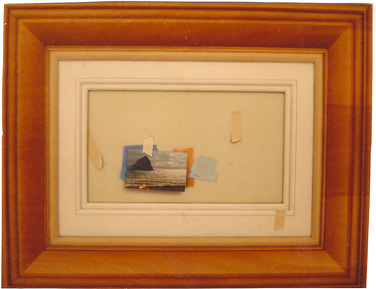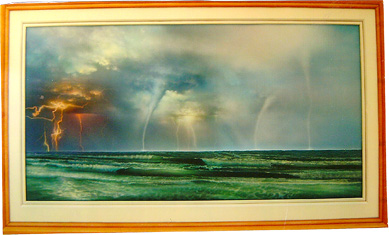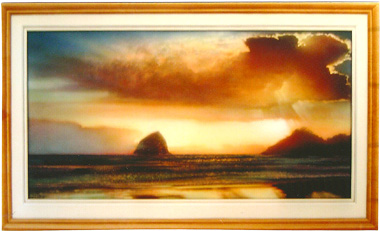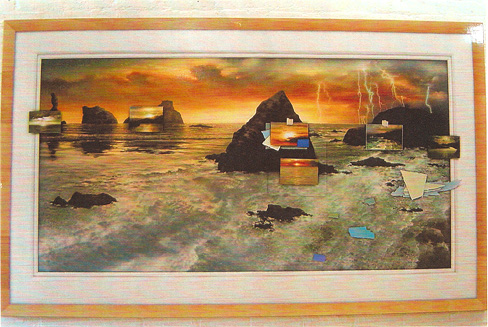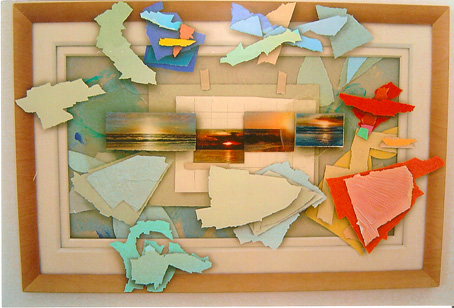Eye Deceptions: The Evolution Of George D. Greenís Painting
From The Late 1970s To The Present
Dalton, Kristin (Fine Arts)
Fritz, Katie (Graphic Design)
Klein, Dustin (Graphic Design)
Meyer, Rachelle (Graphic Design)
Schanzenbach, Luke (Graphic Design)
South Dakota State University – Spring 2008
Course: ARTH 490 – Seminar BETWEEN OBJECT AND PROCESS
Guest Editor and Project Coordinator: Dr. Leda Cempellin, Art Historian
All the images of paintings by George D. Green are reproduced courtesy of the artist. Our sincere gratitude to Dr. Dorothy I. Mitstifer for the final revision of this essay and to Louis K. Meisel for his interest in scholarly projects on this artist.(Click images to view larger version. Javascript required.)
The 2000s: Horizontal Framed LandscapesBy the early 2000s, the wooden imagery will increasingly look like an actual frame for a window; the little ocean scenes occupy more and more space until they dominate the subject matter. Previously enclosed in wooden-like alcoves and juxtaposed in one painting (see Gravityspool, Fig. 22), in the next phase of horizontal paintings they will spread into multiple-panel structures. This visual narration can be traced back to the Renaissance.
The narration leads us inside the picture but only where the artist wants us to go. The hierarchy of this visual story draws emphasis to the objects in relation to their degree of depth, a practice fully developed during the Renaissance period. In all of Green’s works of the late 1990s and early 2000s, he added shadows behind some elements to increase depth. Layering is huge in Green’s work, with clusters of wooden elements, substantial trompe-l’oeil frames, paint daubs, painted paint strips, and background imagery adding to the effect of depth of field. It seems to viewers as if they could walk through the painting, traveling into space, and observing different elements of the painting along the way. Green is very effective in making his work seem to travel on into infinite space. Hanna Hoch’s Der Traum seines Lebens ( Fig. 43) is a photomontage that uses some of the same layering effects. In Der Traum, Hoch emphasized the figure through frames. Sometimes, it seems as though Green uses his painted wooden frames to cover what lies behind. Both artists achieve the same dimensional layering effect, which anticipates the postmodernist conviction that objects and images are polyvalent and allow them to express the contradictory and paradoxical ideas they encounter in the modern world. It is not that the contemporary world is any more contradictory or paradoxical than the past, but with the current technological age society is bombarded with these types of messages daily. “Morning breakfast may be accompanied by radio or television announcements of a butchery in the Mid-East followed, without interval, by the sounds of people joyously discussing the merits of clothing bleach” (Todd 61), which reminds us of the eclecticism with which Andy Warhol duplicated images over and over to try and convey the jaded mindset the media creates for people. By showing images over and over, people are bound to get used to them, and those images will become part of daily life, nothing out of the ordinary. Multi-image artists have been trying to make sense of this bombardment of information. Green’s works from 2000 onward contain an illusionary wooden frame. A similar use of the painted frame is not uncommon among European Renaissance masters. For instance when Jan van Eyck painted The Annunciation Diptych ( Fig. 35: http://www.museothyssen.org/.../obras_ficha_texto_print660.html ), he allowed the painted figure statuette to reach outside the border of the frame. Green did something similar in Pictures from the Monroe Sphere, 2001 ( Fig. 26) when he allowed the abstract shapes to travel into and outside of the frame. In another Untitled piece of 2003 ( Fig. 28), Green painted a frame with nearly an absence of imagery. Depicted elements, such as a photograph, tape, and paper scraps, are the only elements held within the frame. Earlier in the Baroque Era, Cornelis Norbertus Gijsbrechts ( Fig. 39: http://www.ivarhagendoorn.com/files/blog/gijsbrechts_1.jpg ) created the illusion of the backside of a canvas with “nothing more than a white tag applied to the surface” (Grootenboer 167). In 2005, Green painted The Elements ( Fig. 30) in two panels. The horizon, which was visible in the depth of a wooden frame until the early 2000s, has now become the entire painting. The right panel represents a coast in Oregon, a real place, and the other is a very unlikely situation in the Oregon coast, a storm with many tornados and some aggressive yet beautiful lightning. They are pieces of events that are distant in space and time but in the painting take place all at once (Cempellin 2007: 10). Perhaps the biggest leap in transition, in these most recent years, occurred in the 2005 painting titled Mendocino to Gold Beach ( Fig. 31) where the landscape took up the entirety of the composition. The powerful brush strokes with thickener added have been totally eliminated; in their place, fine old-fashioned strokes create realistic imagery. In all of Green’s previous paintings, he utilized depth and texture purely for the sake of visual aesthetics. However, in Mendocino to Gold Beach, Green used fine strokes to render a real life landscape. The insertion of fluctuating painted images, related to memory, can be traced back to works by Ben Schonzeit. In After the Hurricane, 1971 ( Fig. 61), Schonzeit placed sugar packets featuring landmarks from Chicago, Washington, and Dallas overlaid onto a photorealistic rendering of a generic city street. A similar composition can be seen in Green’s Mendocino to Gold Beach ( Fig. 31). Green created a photorealistic image and placed photographs of different locations. In Schonzeit’s work the sugar packets act as a roadmap that tells the viewer where he has been and where he is now. He is painting the present location with the help of past experiences (Riley 117). Green does something similar in that he is painting a new location by picking and choosing from past locations he has visited. Both artists use souvenirs as references to better capture a new environment or, at the least, allow the viewer to see the process of creating art. An offshoot of Magritte’s idea of the painting within a painting is the painting of a photograph within a painting. Green painted photographs over a convincing ocean scene. The photographs are also ocean scenes and therefore create a situation found in The Human Condition ( Fig. 44: http://www.uh.edu/~englmi/i/trompe/trompeloeilBorges-01.jpg), where the artist allows the viewer a glimpse at the process of making a painting. The photographs serve as the research an artist would use in creating a trompe-l’oeil work. The photographs are evidence of past events that lead up to creating new ones, in this case a painting. In Zone of Middle Dimension I, 2007 ( Fig. 32), Green tricks us with frames, with portholes, and he is controlling the viewer more than before. The illusion is incredible, but it seems that it is more than just an attempt to fool the viewer. Now instead of just working to create three-dimensional effects with the canvas’ overall shape, the illusion is now created by the depicted frames of the painting. Again, in a return of Renaissance-based space, the frames are like a window leading to another world—in this case a beach or clouds; at the same time in Modernist terms, these depicted and flat frames are minimalist abstractions, a flat contradiction to the recession in depth. In theory all paintings are abstract, and maybe this is exactly the idea that Green tries to convey to his audience. In tricking us into believing that the piece is a real object, he bends the lines of reality, therefore turning reality into abstraction and abstraction into reality. He makes your mind turn in circles because his paintings are just one large contradiction. Green seems to communicate that no matter the amount of planning and the work that goes into creating an abstract idea, abstraction must first begin with something real; realism is the soul of abstraction and vice versa. ConclusionThe evolution of George Green’s work reflects his willingness to change. As Hans Hofmann once said: “The one who is willing to move forward can achieve and hold balance. The one who tries to stand still or is hesitant to move is bound to fail” (Hofmann 1969: 17). Similarly, Green defined his art as evolving by continuous “ acceptance of chance and error in my paintings” (Green in Cempellin 2007: 11). Through continuous evolution, he keeps an active voice in today’s art scene. Green’s deep involvement in art seems paradoxical, considering his stance on his work: “I am not hostile to the notion of making art; it is also not something that has interested me much” (Green 2/16/08). This paradox of reluctance to adhere to the traditions of making art has been also observed by Sol LeWitt,
Furthermore, Green described his stance on this topic:
Green creates “pictures” for his own “personal wonderment” that challenge him to produce a new visual energy in each work and are not necessarily planned for the inspection of critics and historians. This aspect makes the pieces much more personal to the artist, because his art is meant to only have intrinsic value. This attitude of making art for art’s sake correlates Green to existentialist artists like Pollock, Hofmann, and many others, who were concerned with “individuality and the uniqueness of subjective experience” (Fineberg 36). However, this intrinsic value, whether intended or not, carries over into society, and consequently it creates an identity for the painter, which in case of Green is his postmodern attitude towards constant evolution through eclectic acceptance of chance and error.
|
||
|
